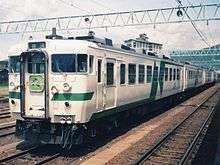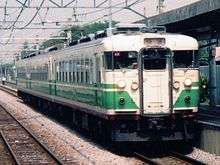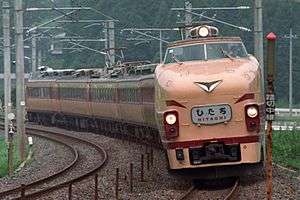169 series
The 169 series (169系) was an express electric multiple unit (EMU) train type introduced in 1969 by Japanese National Railways (JNR), and later operated by East Japan Railway Company (JR East) until 1996 and by Shinano Railway in Nagano Prefecture until 2013. The 169 series was developed from the 165 series EMUs.
| 169 series | |
|---|---|
 A 169 series set in Shonan livery in July 1982 | |
| In service | 1969–2013 |
| Number built | 187 vehicles |
| Number in service | None |
| Number preserved | 4 vehicles |
| Operator(s) | JNR (1969–1987) JR East (1987–1996) Shinano Railway (1997–2013) |
| Specifications | |
| Maximum speed | 110 km/h (70 mph) |
| Traction system | Resistor control |
| Power supply | 1,500 V DC overhead |
| Bogies | DT32, TR69 |
| Multiple working | 165 series |
| Track gauge | 1,067 mm (3 ft 6 in) |
Interior
 Interior of Mitaka Depot set modified with reclining seats for use on Shinkansen Relay rapid services, 2001
Interior of Mitaka Depot set modified with reclining seats for use on Shinkansen Relay rapid services, 2001
Livery variations
 "New Express" livery in 1987
"New Express" livery in 1987 Early "Nagano" livery in 1991
Early "Nagano" livery in 1991 "Shinshu" livery
"Shinshu" livery Shinkansen Relay livery in May 2001
Shinkansen Relay livery in May 2001
Shinano Railway
The third-sector operator Shinano Railway operated a fleet of three 3-car 169 series sets (numbered S51 to S53) formerly operated by JR East. These operated on services between Karuizawa and Togura Stations.[1] These sets were scheduled to be withdrawn from regular service in April 2013, with final runs on 29 April 2013.[2]
Formations
The 3-car sets operated by Shinano Railway were formed as shown below, with two motored cars (KuMoHa and MoHa) and one trailer car (KuHa).[1]
| Numbering | KuMoHa 169 | MoHa 168 | KuHa 169 |
|---|
The MoHa 168 car was fitted with one lozenge-type pantograph.[1]
 Shinano Railway 169 series set S51 in January 2011
Shinano Railway 169 series set S51 in January 2011.jpg) Shinano Railway 169 series set S52 in JNR Shonan livery in March 2013
Shinano Railway 169 series set S52 in JNR Shonan livery in March 2013- Interior of a Shinano Railway 169 series
Preserved examples
As of 2014, four 169 series cars are preserved, as follows.[3]
- KuMoHa 169 1: Next to Sakaki Station on the Shinano Railway in Sakaki, Nagano
- KuMoHa 169 6: Next to Karuizawa Station in Karuizawa, Nagano
- KuHa 169 27: Next to Sakaki Station on the Shinano Railway in Sakaki, Nagano
- MoHa 168 1: Next to Sakaki Station on the Shinano Railway in Sakaki, Nagano
 Preserved KuMoHa 169 6 next to Karuizawa Station in July 2016
Preserved KuMoHa 169 6 next to Karuizawa Station in July 2016 The cab end of car KuMoHa 169 27 preserved next to Shimoyoshida Station on the Fujikyuko Line in Yamanashi Prefecture
The cab end of car KuMoHa 169 27 preserved next to Shimoyoshida Station on the Fujikyuko Line in Yamanashi Prefecture
References
- 私鉄車両編成表 2012 [Private Railway Rolling Stock Formations - 2012]. Japan: JRR. July 2012. p. 91. ISBN 978-4-330-29911-2.
- "Last Run" (PDF). News release (in Japanese). Japan: Shinano Railway. 4 December 2012. Retrieved 5 December 2012.
- Sasada, Masahiro (25 November 2014). 国鉄&jr 保存車大全 2015-2016 国鉄&JR保存車大全2015-2016 [JNR & JR Preserved Rolling Stock Complete Guide 2015-2016] (in Japanese). Tokyo, Japan: Ikaros Publications Ltd. p. 123. ISBN 978-4863209282.
External links
| Wikimedia Commons has media related to 169 series. |
- "JR East 169 series". jreast.co.jp (in Japanese). Archived from the original on 10 June 2001. Retrieved 16 August 2016.
